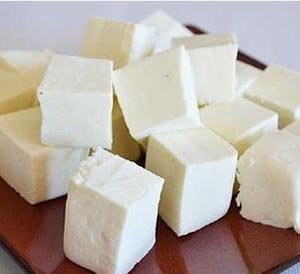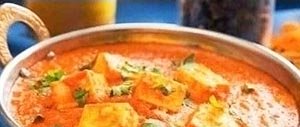Paneer-Indian Cottage cheese
Paneer (पनीर), also known as penir, is a kind of fresh, soft, unripened cheese obtained from the coagulation of cow or buffalo milk. It is also known by chhana (chhena) in Bangladesh and the West Bengal state of India. Paneer is another choice of low-calorie cheese, similar to cottage cheese, for anyone following a low-fat diet.
Processing of dairy to paneer technology existed in the plains of Northern India during the time of ancient Indus Valley civilization.
 |
| Fresh paneer-Indian cheese. |
Preparation of cottage cheese:
In its simplistic form, paneer preparation demands less time and equipment than most other soft, semi-soft, or hard cheeses.
Full cream, pasteurized cow, or buffalo milk intended to prepare paneer cheese is poured into a clean, wide-mouthed bowl and heated till it reaches a near-boiling point (75 degrees F).
In the next step, add food acid like lemon juice (citric acid) to milk while the milk continues to boil. Approx. 10 ml of lemon juice or vinegar per liter of milk is required to curdle milk. Continue to heat milk for another 5-10 minutes under low heat while stirring to help even distribute acids and to prevent scorching of milk at the bottom.
Once you see enough curdling done, turn off the stove. Allow curds to separate from the whey for about 15-30 minutes. Then, drain the curd using a cheesecloth until all the whey is drained out. Dip the cheese in cold/ice water for 20-30 minutes to give it a good texture and appearance.
Paneer cheese shall not contain more than 70 percent moisture and the milk fat content shall not be less than 50 percent of the dry matter.
Chhana or chhena/sana (in Assamese) is a milk solid obtained by coagulation of cow or buffalo milk with sour cream buttermilk (SCBM), lactic acid, or citric acid, and subsequent drainage of whey. Chhena is an indigenous cheese product of Odisha, West Bengal states of Eastern India, and neighboring Bangladesh which serves as the base for a large variety of Indian sweets.
Nutrition facts and Health benefits of Paneer cheese
Paneer has an almost similar nutritional profile as cottage cheese. It is one of the nutritious, low-calorie dairy products; carries 80 cal/100g, 10-15% protein, and small amounts of high-calorie fats and sugars. It, therefore, is quite popular and a portion of excellent food for people who are on diet programs.
It provides high-quality protein that is rich in all essential amino acids required for growth and development and helps stay healthy.
Paneer is a low-lactose dairy product and contains minimal amount of lactose (0.1 g/oz) making it one of the good sources of protein and minerals for those with lactose intolerance. During the curdling process, most of the naturally occurring lactose in milk is converted into more easily digestible lactic acid.
Like other dairy cheeses, is free of gluten. It, therefore, is an important source of gluten-free food that is rich in protein, minerals, and vitamins.
Paneer contains good amounts of calcium, magnesium, and phosphorous; and together with vitamin D, Paneer ensures sufficient nutrients available for bone growth, especially in children.
Regular consumption helps in preventing osteoporosis. Calcium plays an important role in building stronger, denser bones early in life and keeping bones strong and healthy later in life. Calcium deficiency can lead to rickets poor blood clotting and osteoporosis. As per recommended dietary allowances (RDA), daily calcium intake should be 1000 milligrams for adult men.
It is a healthy food product since most of the constituents in skim milk undergo biochemical changes into more easily digestible and health-benefiting products.
It contains all the vitamins available in the milk, both fat-soluble and B-complex group of vitamins. It is particularly rich in riboflavin and vitamin A (236 IU/100g).
Being soft and fresh cheese, paneer contains modest levels of minerals, especially calcium (10% of RDI), phosphorus (22% of RDI), and magnesium.
| Principle | Nutrient Value | Percent of RDA |
|---|---|---|
| Energy | 80 Kcal | 4% |
| Carbohydrates | 4.31g | 3.3% |
| Protein | 11 g | 20% |
| Total Fat | 2.3g | 11% |
| Dietary Fiber | 0 g | 0% |
| Vitamins | ||
| Folates | 10 μg | 2.5% |
| Niacin | 0.09 mg | <1% |
| Pyridoxine | 0.057 mg | 4% |
| Riboflavin | 0.234 mg | 18% |
| Thiamin | 0.020 mg | 2% |
| Vitamin-A | 230 IU | 7.66% |
| Vitamin-C | 0 mg | 0% |
| Vitamin-D | 0 IU | 0% |
| Vitamin-E | 0.08 mg | <1% |
| Vitamin K | 0 µg | 0% |
| Electrolytes | ||
| Sodium | 321 mg | 21% |
| Potassium | 120 mg | 2.55% |
| Minerals | ||
| Calcium | 103 mg | 10% |
| Copper | 0.033 mg | 4% |
| Iron | 0.13 mg | 1.75% |
| Magnesium | 8.9 mg | 2% |
| Manganese | 0.015 mg | <1% |
| Phosphorus | 148 mg | 22% |
| Zinc | 0.61 mg | 5.5% |
Buying
Fresh paneer cheese is readily available year-round in grocery stores and dairy booths in India, Bangladesh, and Pakistan. Soft, semi-firm, creamed (malai paneer-equivalent to creamed cottage cheese), diced or in blocks, tinned or vacuum packed, ready to use paneer cheese can be easily available depending on your meal plan.
Buy paneer having smooth, uniform texture and softness from reputed manufacturers. It should have a milky-white color, and pleasant smell, and an appealing taste.
Avoid excess moisture or water dipping. Do not buy a loose product from retail shops as it might be contaminated with foreign matter/particles and adulterants and off-flavored.Storing
Similar to other soft and non-aged dairy products, paneer is highly perishable because of its high moisture contents. Store inside the home refrigerator 2-3 days below 80 degrees F. In a way similar to cottage cheese, if you prepare at home, make small batches frequently and store well in the fridge for up to a week.
In the deep freezer, paneer stays well for a couple of months.
Food uses
Like cottage cheese, fresh paneer also very convenient and versatile to use. It can be enjoyed with a little bit of seasoning and mixed in fruits and vegetable salads.
Paneer cheese is many food combinations. Traditional milk solids recipes usually revolve around homemade paneer cheese in India, Pakistan, and Bangladesh, be it appetizers main dishes, and desserts.
Here are some serving tips
 |
| Shahi paneer |
Chhena is the base ingredient in mouth-watering Bengali sweets like rasomalai, rasogolla (রসগোল্লা), sandesh, chum-chum, chhana murki, chhana balushahi, khurma/belgrami, chhena goja, pantua etc.
Paneer palak (with spinach), matter paneer (with green peas), shahi paneer are popular savory recipes in India and Pakistan.
Skewed paneer cubes roasted in traditional oven (paneer tandoor tikki) is a popular snack in Punjab provinces of India and Pakistan.
Paneer cheese stuffed bread with yogurt and pickle is another traditional North Indian and Pakistan breakfast dish.
Paneer cubes mixed in cashew, herbs paste -butter-paneer masala is a delicious curry dish served with unleavened slices of bread is a popular dish in Northern India.
Safety profile
Unlike hard and aged cheeses, paneer and cottage are low sodium, low-fat dairy items and contain small amounts of saturated fats and cholesterol, and therefore, recommended as a healthy dairy product for those who are on a low sodium and fat diet program.
Skim-milk paneer cheese contains small amounts of tyramine and can be eaten in small quantities by those on the tyramine-restricted diet. (Source: Queensland Government-low tyramine diet: MAOI's and diet.)
Safety profile
Unlike hard and aged cheeses, paneer and cottage are low sodium, low-fat dairy items and contains small amounts of saturated fats and cholesterol, and therefore, recommended as healthy dairy product for those who on low sodium and fat diet program.
Skim-milk paneer cheese contains small amounts of tyramine and can be eaten in small quantities by those on the tyramine-restricted diet. (Source: Queensland Government-low tyramine diet: MAOI's and diet.)
Read further on:
≺≺ Understanding Lactose Intolerance and How to Manage It
≺≺ Cheddar cheese nutrition facts.
≻≻- Back to Nutrition articles from Paneer cheese nutrition facts.
≻≻- Back to Home page.
Further Resources:
USDA National Nutrient Database. (opens in new window).
Paneer production -A Review. (opens in new window).
Queensland Government- low tyramine diet.
Academia- Paneer: A Very Popular Milk Product in Indian Sub-continent.. PDF (opens in new window)